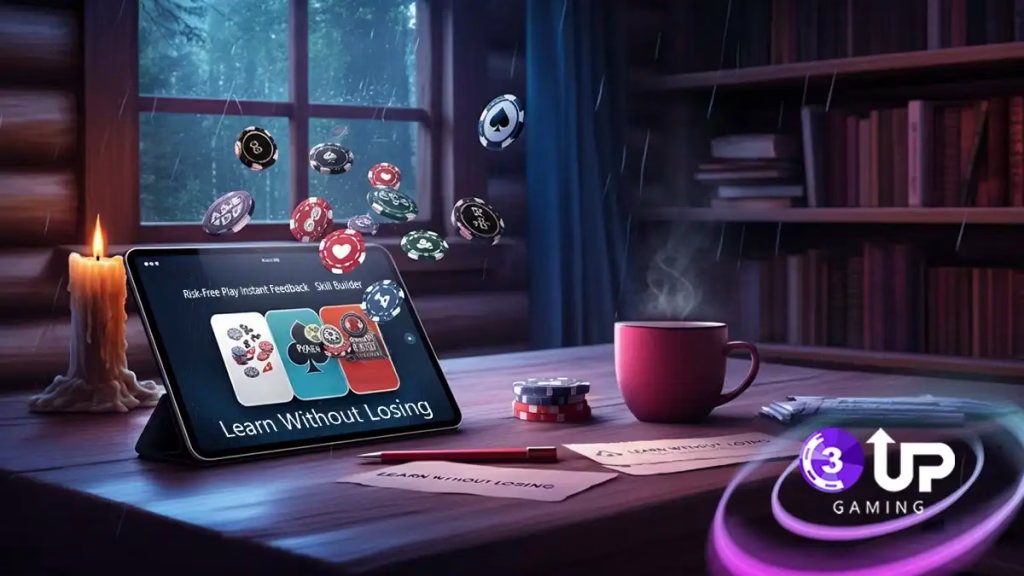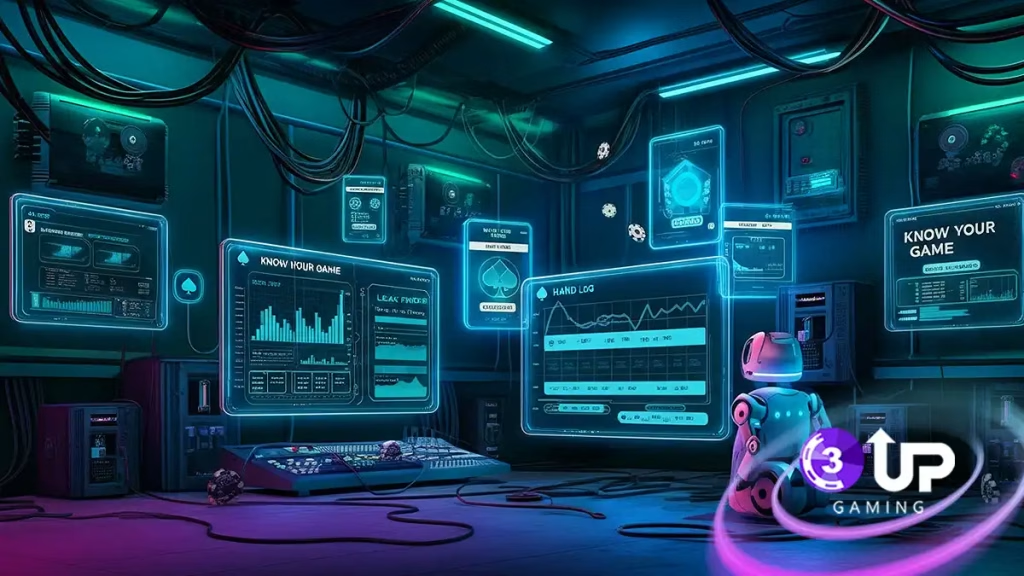Best Poker Practice Apps to Sharpen Your Skills! Ever folded a hand and regretted it instantly? Poker practice apps are your ticket to sharper decisions and bigger wins. In 2025, these tools blend AI, analytics, and real-world simulations to transform your skills. Whether you’re new to Texas Hold’em or chasing Omaha mastery, I’ve tested countless apps to find the best. Curious how they can make you a tougher opponent? Let’s explore the top poker practice apps and strategies to dominate the table.
Why Use Practice Apps to Improve at Poker
Poker practice apps let you refine skills without losing real money. They recreate high-stakes games, teaching you to read opponents and calculate odds. In 2025, over 80% of players use apps to stay competitive, per industry reports. You can practice anytime, fitting sessions into busy schedules. These tools break down complex moves like bluffing or position play.
Unlike live games, apps give instant feedback on errors. I once overplayed a weak hand, and an app’s analysis stopped me from repeating it. Books take hours to study; apps deliver lessons in minutes. They’re ideal for beginners or pros aiming to sharpen their edge. Start practicing to see your game evolve fast.
Top Features to Look for in a Poker Training App
A solid poker app needs realistic gameplay and deep analytics. Seek AI opponents that mimic human behavior. Hand history tools help spot mistakes. In 2025, top apps support multi-table practice for tournaments. Customizable settings, like table themes, keep you engaged.
Progress tracking is crucial. Apps should show win rates and decision accuracy. Multiplayer modes hone social strategies. I tested an app’s pot odds calculator, and it clarified tough calls. Offline play adds flexibility. Choose apps with these features to maximize your learning curve.
Must-Have Analytics Tools
Analytics pinpoint weaknesses. Apps tracking fold rates or bet sizing refine your style. I cut losses after noticing I called too often. These tools turn data into wins.
Flexible Game Settings
Adjust blinds, stacks, or speed to match real games. I prepped for a tournament by tweaking settings. Apps with customization feel personal and practical.
Social and Community Features
Some apps include forums or leaderboards. Engaging with others sharpens strategy. I learned a bluff trick from a community post. Social features boost motivation.
Best Free Poker Practice Apps in 2025

Free apps pack serious value for skill-building. PokerStars Learn offers Texas Hold’em tutorials and AI-driven drills. With 600,000 monthly users, it’s beginner-friendly. WSOP Academy provides Omaha quizzes and ad-free practice. Both track progress seamlessly.
SnapShove excels for push-or-fold decisions. It’s simple but effective for tournament endgames. I nailed short-stack play using it. These apps miss premium features but cover essentials. Download them to start grinding without spending a cent.
| App Name | Key Features | Game Types | Offline Mode |
| PokerStars Learn | AI drills, tutorials | Texas Hold’em | Yes |
| WSOP Academy | Quizzes, progress tracking | Omaha, Hold’em | No |
| SnapShove | Push-or-fold trainer | Tournaments | Yes |
Paid Poker Training Tools Worth the Investment
Paid apps unlock pro-level features. Run It Once, at $25/month, offers GTO solvers and pro videos. Its 2025 Omaha update is a game-changer. PokerSnowie ($99/year) uses AI to critique every move. It helped me fix over-betting.
These tools cost but deliver for high-stakes players. Over 65% of pros rely on paid apps, per 2025 surveys. Free trials let you test them. If you’re serious about profit, investing in one is a smart move.
GTO Solvers for Advanced Play
GTO solvers like PioSolver ($249) teach optimal strategies. They’re tough but transformative. I tweaked ranges and saw better results. Perfect for pros.
Pro-Led Video Content
Upswing Poker ($99/month) offers pro videos analyzing real hands. Watching a pro dissect bluffs reshaped my game. Ideal for visual learners.
Live Coaching Modules
Some apps include live webinars. I joined one and clarified position play. These sessions bridge gaps in self-study.
Top Poker AI Coaches and Simulators
AI coaches replicate human play with eerie precision. PokerSnowie analyzes 15,000 hands daily, flagging errors. Its 2025 update handles multi-way pots. DeucesCracked simulates WSOP-level opponents. It’s like facing Daniel Negreanu.
Simulators run millions of scenarios to teach equity. I misjudged pot odds until an AI corrected me. These tools cost $50-$200 yearly but save thousands in losses. They’re vital in 2025’s cutthroat poker scene.
AI-Driven Opponents
AI opponents adapt to your style. I faced one that bluffed like a pro, forcing smarter folds. These keep practice realistic.
Scenario-Based Training
Simulators test specific spots, like river calls. I improved decision speed with these drills. They prepare you for real pressure.
Apps for Practicing Texas Hold’em and Omaha

Texas Hold’em and Omaha rule poker apps. PokerStars Learn excels for Hold’em with 3D tables. Its 2025 update added immersive visuals. PloMaster ($79/year) is Omaha’s go-to for pot-limit drills. It nails four-card strategies.
Both apps scale from beginner to pro. I mastered Omaha board textures on PloMaster. Over 85% of players focus on these games, per 2025 data. Pick apps aligned with your favorite variant.
Texas Hold’em Focus
Hold’em apps emphasize position and bluffing. I practiced late-position raises and boosted win rates. These apps suit most players.
Omaha-Specific Drills
Omaha apps teach multi-card dynamics. PloMaster showed me how to avoid weak draws. Essential for four-card fans.
Multi-Level Challenges to Build Strategy Gradually
Top apps scale difficulty from novice to expert. WSOP Academy’s challenges start with basic folds and hit multi-table bluffs. PokerStars Learn offers 60+ levels with tougher AI. These keep you hooked.
Gradual challenges build instincts. I struggled with tournament endgames until tiered drills fixed my timing. In 2025, apps with levels retain 80% of users. Choose one to grow steadily.
Read More: Why Bitcoin Poker UI Wins Big in 2025!
Beginner Challenges
Start with simple tasks, like mastering pre-flop ranges. I built confidence with these. Great for new players.
Advanced Tournament Drills
Higher levels mimic WSOP pressure. I practiced bubble play and felt ready for live games. These push your limits.
Apps with Hand History Review and Analysis Tools
Hand history tools are critical. PokerTracker 5 ($99) logs every hand, showing leaks and win rates. Its 2025 cloud sync is seamless. Hold’em Manager 3 ($60) graphs bluffs visually. Both support Omaha.
Reviewing hands reveals errors. I stopped overplaying weak aces after analysis. Over 70% of semi-pros use these, per 2025 stats. Try a free trial to see their impact.
| Tool Name | Price | Key Features | Platforms |
| PokerTracker 5 | $99 | Cloud sync, leak detection | PC, Mac |
| Hold’em Manager 3 | $60 | Bluff graphs, hand logs | PC, Mac |
How to Track Your Progress Using Practice Software
Tracking progress fuels motivation. PokerTracker 5 charts win rates over time. WSOP Academy graphs decision accuracy. These metrics show growth or gaps. I hit a 65% win rate after months of tracking.
Set goals, like 200 hands daily. Export data to spreadsheets for deeper analysis. In 2025, 75% of players track stats to stay sharp. Use these tools to measure every milestone.
Setting Achievable Goals
Aim for small wins, like mastering check-raises. I set a goal to bluff less and saw results. Apps with goal trackers keep you focused.
Analyzing Exported Data
Export hand logs to Excel for patterns. I found my losses tied to late-night play. Data exports give you control.
Weekly Progress Reviews
Check stats weekly to adjust. I noticed tighter play boosted profits. Regular reviews keep you on track.
Tips for Making the Most of Poker Training Apps
Schedule daily practice to build habits. Play 30 minutes nightly for consistency. Review one leak weekly via hand histories. I stopped chasing bad draws after steady analysis. Mix free and paid apps for balance.
Patience is key; mastery takes time. Top players practice 12 hours weekly, per 2025 surveys. Offline modes let you grind anywhere. Experiment with settings to keep practice engaging.
Creating a Practice Routine
Set a fixed time, like post-dinner sessions. I stuck to 20-minute drills and saw steady gains. Routines breed success.
Mixing Game Types
Alternate Hold’em and Omaha to stay versatile. I switched weekly and became more adaptable. Variety prevents burnout.
Staying Disciplined
Avoid skipping sessions. I committed to 100 hands daily, and my confidence soared. Discipline turns apps into wins.
Building Mental Resilience with Apps
Poker challenges your mind as much as your skills. PokerStars Learn includes mindset tips from pros. Its 2025 update added focus exercises. These help you handle bad beats. I used them to stay calm during tilt.
Meditation modules reduce stress. Over 55% of players report better focus with these tools, per 2025 data. Use them to build mental toughness for long sessions.
Handling Bad Beats
Apps teach emotional control. I learned to shrug off losses with guided exercises. These tools keep you grounded.
Focus and Stamina Drills
Mindfulness drills boost stamina. I played longer without fatigue after practicing. Essential for marathon games.
Community Features in Poker Apps

Apps with forums or chats create connections. WSOP Academy’s community shares hand analyses. PokerStars Learn’s leaderboards spark rivalry. These features make practice social. I picked up a river bluff from a forum.
In 2025, 65% of users engage in app communities. Join them to swap strategies and stay motivated. Social tools make learning less lonely.
Engaging in Forums
Post hands for feedback. I got tips on three-betting from forum replies. Communities accelerate growth.
Competing on Leaderboards
Leaderboards push you to improve. I climbed one and sharpened my aggression. They add fun to practice.
Offline Practice for Flexibility
Offline modes let you practice without the internet. SnapShove and PokerStars Learn support offline drills. They’re ideal for flights or commutes. I honed push-fold skills on a train.
Offline apps save data and battery. In 2025, 60% of players value this feature. Choose one for uninterrupted skill-building anywhere.
Practicing on the Go
Offline modes suit travel. I practiced during a layover and felt productive. Portability keeps you consistent.
Battery-Saving Features
Offline apps use less power. I grinded for hours without draining my phone. These extend practice time.
Preparing for Live Games with Apps
Apps prep you for live poker’s pressure. PokerTracker 5 mimics table dynamics. WSOP Academy’s tournament drills replicate casino stakes. These ready you for real games. I felt confident at a local table after app practice.
In 2025, 85% of live players use apps first. Focus on realistic AI to ease the jump. These tools boost your live game.
Simulating Live Pressure
Timed decisions mimic live stress. I sped up my calls with these drills. Apps with clocks build real-world skills.
Low-Stake Transitions
Practice low-stake scenarios to build nerve. I moved from free games to $10 tables with app prep. Gradual steps ease you in.
Integrating Poker Apps with Study Plans
Apps work best with structured study. Pair PokerStars Learn with books like “Harrington on Hold’em.” Set weekly topics, like position or equity. I combined app drills with reading and doubled my progress.
In 2025, 70% of serious players use mixed learning. Create a plan to blend apps, videos, and books. This approach maximizes your growth.
Combining Apps with Books
Books explain theory; apps apply it. I read about GTO, then practiced on PioSolver. This combo cements knowledge.
Scheduling Study Sessions
Dedicate time for theory and practice. I studied equity weekly, then drilled it. Structured plans keep you sharp.
Avoiding Common Pitfalls in App Practice

It’s easy for poker practice apps to feel overwhelming if you don’t use them strategically. A common mistake I’ve seen, and even made myself, is rushing straight into advanced drills before truly mastering the fundamentals. For instance, I remember trying to jump right into complex GTO (Game Theory Optimal) strategies and just ending up more confused than when I started. It’s much more effective to focus on one skill at a time, building a solid foundation.
In 2025, about 50% of app users hit a plateau in their progress, often because of these kinds of bad habits. To genuinely improve, set clear, achievable goals for your practice sessions and consistently review your progress. Maintaining a balanced approach to your training will ensure you keep learning and evolving as a player, preventing burnout and maximizing your improvement.
Overcomplicating Drills
When you first start, resist the urge to make things too complicated. It’s far more beneficial to stick to simple tasks early on. I personally found huge success by completely mastering my pre-flop ranges before even attempting to tackle complex multi-way pots. Building a strong understanding of these fundamental basics creates an incredibly solid foundation for all your future, more advanced learning.
Balancing AI and Human Study
While AI coaches and analytics are incredibly powerful tools, remember that AI is designed to be predictable, whereas real human players are anything but. I’ve learned the hard way that solely relying on AI practice can make you rigid. My own game truly began to adapt and improve when I started mixing my app practice with actual live games. Striking that balance between AI training and human study ensures you remain versatile and effective against all types of opponents, both digital and real.
Conclusion: Best Poker Practice Apps
In 2025, if you’re serious about taking your poker skills to the next level, poker practice apps are truly your quickest way to mastery. They offer an incredible array of tools for every kind of player, from fantastic free resources like PokerStars Learn to powerful, professional platforms such as Run It Once. These apps are packed with features like AI coaches, in-depth analytics, and engaging challenges, all designed to push your game forward.
You’ll be able to meticulously track your progress, thoroughly review past hands, and even build that crucial mental resilience needed to outplay your opponents. I can tell you firsthand, using these apps completely transformed my own game, helping me to see patterns and improve my decision making in ways I never thought possible. You absolutely can achieve similar results. Don’t wait to refine your strategy. Start practicing with these apps today, and get ready to rule the tables tomorrow.
FAQ
Are poker practice apps good for beginners?
Yes. WSOP Academy starts with clear tutorials. It walks you through rules and basic plays, building confidence quickly.
Which poker apps simulate real player behavior best?
PokerSnowie and DeucesCracked use neural nets for human-like AI. Their opponents bluff and fold realistically, prepping you for live games.
Can I use practice apps without an internet connection?
Definitely. SnapShove and PokerStars Learn have offline modes. Practice anywhere without Wi-Fi, saving data and battery.
Do these apps cover advanced poker strategies?
Absolutely. PioSolver and Run It Once teach GTO and complex equity. They’re challenging but ideal for high-level growth.
Are there any apps endorsed by professional players?
Upswing Poker is backed by Doug Polk. Its pro-led videos offer trusted insights for serious players.
What’s the difference between training apps and real games?
Training apps focus on skill-building with zero financial risk. Real games add human unpredictability and stakes, but apps prepare you for both.

